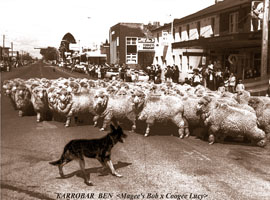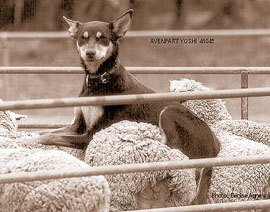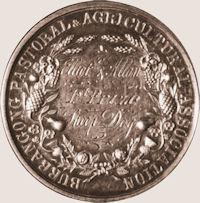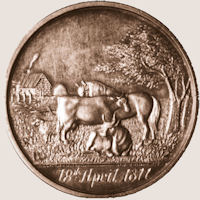

Historically it is interesting to observe that the dogs which formed the foundation of the Australian Working Kelpie sheepdog were not owned, as one might expect, by shepherds, but land/property holders who were members of highly respected and well known families. George Robertson and his cousin John G Robertson came from Lanark district of Scotland to Tasmania later to Victoria; 5 Rutherford brothers immigrated to Australia in the mid 1800 from a very well established sheep farming family in Sutherlandshire. Gilbert S Elliot and William Allan were both sons of very well 'connected' families in England and Scotland.
Very comprehensive research over a long period by members of WKC historical research team has yielded interesting family backgrounds of these men who unknowingly introduced the dogs, all of which proved to be ideally suited to the harsh Australian conditions and which by sheer chance came to a geographically small area of NSW - small enough for the interbreeding of the strains. The foundation of the Kelpie breed happened by sheer chance and the results have been of tremendous value to the Australian pastoral industries.
The following is one of three articles outlining the background of the 3 founders of the Kelpie and their dogs. When space permits a similar article about the Rutherford’s and the Robertson’s will be included. Any additional information members may have, will always be very much appreciated.

Gilbert S Elliot and William Allen
The precise date of arrival of Gilbert Elliot and William Allen is not know at the present time however it is assumed that they met either through William Allan’s cousin the Hon William Campbell or whilst jackarooing, however based on family information this appears to have been between 1865 - 1868. Gilbert Elliot returned to England and married in 1868 before returning and going into partnership with his friend William Allan. They purchased ‘Geraldra’ station, in the district of Cootamundra, County of Bland, a property quoted as having been occupied by Edward Ryan from 1849 when Ryan with a claimed lease of 92,160 acres until 1866 when it comprised 19,200 acres. A reference in Goulburn Herald (date unknown Gormly Index) indicates that Ryan occupied earlier: ‘Edward Ryan got a licence for a run on Yeo Yeo Creek (Geraldra run) on 1/7/1842. Ryan built stockyard at Old Man Yeo Yeo 1841 later he was forced to remove it being the only water in that part of the district.’ In 1866 'Geraldra' was transferred to John Donnelly who transferred to James Kennedy. The first reference to Geraldra in the hands of Elliott and Allan was in 1869/70 In 1871 the property is recorded in names of W Allan, G S Elliot & A Robinson the latter was Gilberts brother in law. Arthur Robinson with Julius Besnard was Stock and Station Agents.
In the 1872 in the Burrangong Argus(13/1/72): Elliot and Allan advertised for Fencers 'with bullock teams to construct 20 miles of Roll-over fencing on 'Geraldra' and on the same day William J Allan JP and Arthur Robinson were listed as Shareholders holding 20 shares each in 'The Phoenix Golf Mining Co Ltd. and Allan & Co. later in the year Elliot & Allan advertised themselves as Stock and Station agents.
On the 23/5/72 Conditional purchases Selections of 320acres each were made at Lands Office with an annual rent of 3 pounds. (CP5823, 5824, 5826) with renewal due 1874. Gov Gaz. 3/6/1874 Goulburn Herald ‘William Allen sold the run with 30,000 sheep to Messrs W & G Davidson.’(Gormly index) The property was not officially transferred by Government Gazette until 1875 and because of Gilbert Elliot’s death it was transferred into William Allan’s name (Gov. Gaz.) before being transferred to W & G Davidson. (References: Hansen Pastoral Possessions, Government Gazettes, Electoral Rolls, Postal Directories and Gormley Indexes and family records)
Gilbert Stanley Elliot
Gilbert S Elliot descends from Gilbert Elliot of Stobs. ‘...The Elliot’s of Stobs produced many celebrities, including the gallant defender of Gibraltar, created Lord Heathfield, Admiral John Elliot, the Earls of Minto; Sir Gilbert Elliot, an accomplished scholar, and Lady Jean Elliot, who wrote a fine version of ‘The Flowers of the Forest’ The Elliot’s were prominent in Border history and frequently they appear in poetry and ballads.......’(Extract: from lengthy and comprehensive articles published ‘Weekly Scotsman’ August 16, 1941.)
Gilbert Stanley Elliot: born c1843 son of William Elliot MD (& Georgina? BMC). Married (aged 35) at Parish Church, Burston, County Surrey - Catherine Maria Robinson (aged 34) daughter of William Robinson (& Catherine? BMC) Issue: 1 son, Allan A Elliot and a daughter born on ‘Geraldra’ Station. Gilbert Elliot died 5/2/1874 as a result of an accident and was buried 7/2/74 Young C of E Cemetery, 1874
The following are extracts from the obituary published in the Burrangong Argus -
‘DEATH OF MR G S ELLIOT ‘It is our painful and unexpected duty to record the demise of the above gentleman, whose accident by being thrown from his buggy. The event took place at 9 o'clock Thursday night from sudden fatal syncope. No symptoms of serious internal injury from the accident had presented themselves.
The deceased gentleman, through not a townsman, has always taken a lively interest in all public local matters, and in fact his visit to Young, at the time of his meeting with the accident which has had such a sorrowful termination, was occasioned by a wish to be present at a meeting of the Farmers Club, of which he was an enthusiastic member. By his casual acquaintances he was generally respected for his urbanity and kindness of manner, and those whom he was on terms of intimacy will, by his death, miss from their circle a friend, a scholar, and a gentleman. He was a Mason, and a member of the Burrangong Lodge of St John, from which lodge he will be buried this afternoon with Masonic honours.'

Not long after death of G.S. Elliot ‘Geraldra’ was sold and his widow and children returned to England. When 21 years of age Gilberts only son Allan A Elliot came back to Australia and joined William Allan as a Jackeroo when Allan owned Whyenbah and Mona station near St George and Braeside near Dalveen. A.A Elliot acquired properties in the Cunnamulla district where he remained until 1924 when he sold out and moved to a property in the Inglewood district where he died in 1959.
William Allan:
William Allan: born 1840 Edinburgh Scotland according to his daughter Mrs Garrett, ‘his father being a writer of the signet (lawyer to us) his mother was Rebecca Lovat-Fraver. Had she been a son, she would have come in for the title 'Lord Lovat'. William came to Australia after the death of his mother at the request of his cousin the Hon. William Campbell who was then living in Victoria. After two years jackarooing in the Wimmera and Riverina districts he and a friend Gilbert Elliot bought ‘Geraldra’ station near Young NSW on Lambing Flat as it was then called. He married whilst on ‘Geraldra’, Emily Mate, 3rd daughter of T H Mate of Tarcutta.
Following the death of his partner Gilbert S Elliot in 1874 he sold out and went to Queensland and bought ‘Whyenbah’ on the Balonne River and ‘Wollerina’ on the Culgoa, a total of 1,100 square miles which together with 20,000 sheep, 40 horses, 4 teams of bullocks, a good homestead (furnished) for a total of 18,000 pounds cash. No close settlement within 250 miles, nearest telegraph station at Condamine 200 miles. After experiencing 7 years of drought he bought ‘Braeside’ and ‘Crystal Mt’ stations between Warwick and Stanthorpe, chiefly because of the beautiful climate. It was there that he indulged in a Hereford Stud and experimented in breeding up a flock of some thousand black merino sheep, their wool then bringing almost double the price of white wool grown in the area, until the aniline dyes were invented and prices dropped, the black sheep cutting less wool than the white.
Entering Parliament he represented his district successfully for electorates of Warwick, Darling Downs and Cunningham Q....’ Daughter Mrs Garrett possesses an account of a farewell dinner given to him, printed on silk (when leaving Young) and a show society medal won by Brutus 1872.
Whilst on 'Gerardia' William Allan JP listed as a steward ‘Burrangong Turf Club; was Vice President and joint Secretary with Mr J T McCarthy of the Burrangong Pastoral and Agricultural Association.
Brutus and Jennie
The pair of black and tan collies were brought out from Jedsbrugh by Arthur Robinson for his brother in law Gilbert Elliot. Following the death of Gilbert Elliot William Allan took Brutus with him to Queensland. Caesar one of the litter born on the way to Australia became the property of Mr John Rich of Narriah station, a property that adjoined Yalgogrin. It was whilst Jack Gleeson was managing Yalgogrin that he mated Kelpie to Caesar to produce the litter of which Kings Kelpie was part. For a long time is was assumed that John Rich got Caesar as a pup but it now seems more likely that he got Caesar later possibly after he competed at the 1873 Burrangong Show.
Because of the short time between the arrival of Brutus and Jennie, Gilbert Elliot’s death and Williams Allan’s move to Queensland the bloodlines of this imported pair was limited and to date the only records held are that Caesar mated to Gleeson’s Kelpie produced Kings Kelpie; Nero owned by James Cunningham of Kildary station; Swan ll and Wylie ll all of which bred on well. Laddie, Caesar litter brother was mated to King's Kelpie to produce the dam of The Barb and a couple of unnamed dogs bred and owned by R M Macpherson.
In a small Booklet compiled and printed 21st July, 1940. By William Allan, son of William of ‘Geraldra’. William Allan Jnr wrote:- ‘As so much misunderstanding exists - and widely - and arguments so often occur, into which I am sometimes drawn, I do not think I can do better that subtract from Mr Robert Kaleski's entertaining book, ‘Australian Barkers and Biters’ Endeavour Press. Though I had some correspondence with the author before publication of his revised edition in 1933, I am afraid I was of little use to him, as the subject of this pamphlet was in the days before my time, for I was born in Queensland, where my father then had a Hereford stud and few sheep.
I remember one episode, however, worth of mention, of my father's telling. He had sold ‘Geraldra’, near Young, in the 70's and had bought ‘Whyenbah’ on the Balonne, having taken ‘Brutus’ with him there. In due course, my father made a trip to the Old Country. During his absence ‘Brutus’, who was old then, moped and pined, and when my people returned, the dog jumped up and effusively greeted his master, then dropped back dead. ‘Caesar’ lived to a great age, and I always understood that my father thought more of him than ‘Brutus’.
‘As to ‘The Barb’ Mr Ernest Edols, once told me that his father, after frequently trying to possess this dog, eventually had to pay his boundary -rider (Davis) pounds 100 for it.’
The following are extracts from an article Mr Robert Kaleski made available for publishing in the A/Asian 15/1/1921 giving an account he received from Mr Phil Mylecharane, who was one of the three judges of the 1879 sheep dog trial at Forbes. The account gives a picture of the working ability of Brutus and Jennie. Mr Mylecharane was quoted as follows:-
'In 1870 I went out to Mr Allen, of Geraldra Station, to buy flock rams for Goldsborough Mort and Company. When I got there Mr Allen told me the rams were out in the paddock, but he would soon get them in for me. So saying he opened the yard gate, whistled up two smooth, prick-eared black and tan dogs, a male and a female, and sent them out into the paddock. In a very short time they were back with the rams, and put them into the yard. I never saw dogs work sheep like these two did, and noticing that the bitch had pups, made up my mind that I must have one.
So after I bought the rams (I took a big lot of them) I asked Mr Allen where he got those dogs. His answer was that they had just imported them from Scotland from a wonderful working strain there; the dog's name was Brutus and the slut Jenny. I asked for a pup. He told me there was only one left, and he though I wouldn't like its colour. We went around to see the pups, and he pointed mine out, a little red-coloured one, exactly like a dingo; the rest were black and tan. I thought that it was a dingo. Mr Allen assured me that this was impossible, as the pups were sired on board, and every care taken. He advised me to take the pup, and he would write home to the breeders and see about it. I took his advice and the pup. The latter turned out a splendid worker. After having him for two years he was stolen from me down at Coolagong, near Forbes. The next time I saw Mr Allen he told me that the breeders of Brutus and Jenny had written back to say that in nearly every litter they got a similar pup to mine and that they were great workers’
Burrangong Pastoral Association Sheepdog Trial 1871
The following is a published account of the sheepdog trial conducted at the Burrangong Show.
‘In sheepdogs there were three entries and the prize taken by a dog the property of Elliott and Allen. The performance of this dog was something wonderful. Three sheep were let loose and taken outside the ground and the dog called upon word being given brought them into the ground and across through a crowd of people running here, there and everywhere in a manner which would confuse a human being, to their pen, without so much as a bark. So uncommonly well did this shepherds friend behave himself that the other competitors resigned all claim to the prize, and would not put their dogs upon trial’ .
The winner was Brutus see inscription on the photograph of the medallion. (Town & Country April 1871 p 518)


The following year 3 dogs were entered one each by Messrs Elliot & Allan, W Rutherford and Wallis Brothers. The newspaper account reads as follows’ ‘The trial between sheepdogs, two of which viz Mr Allen's and Mr W Rutherfords entered the lists - was very interesting. The animals were both thoroughly under control and evidently masters of their business, and through a long and severe trial many were the bets hazarded as to how the judges Messrs Todd and Mammond (? Hammond), would give their decision. The preference was, however, in the end given to Mr Allan's entry the same dog which took the prize and even frightened all competitors from the field last year.’ (Burrangong Argus July 1872) In 1873 G S Elliott Scotch Collie dogs Caesar and Jessie received an honourable mention the only other dogs were exhibited by Mr M McGrath. No results have been found covering a trial of sheepdogs in either 1874 or 1875. A reference in 1875 the Show results states that there were no entries. The 1872 medallion is in the possession of Mrs Garrett.